Your heart is pounding, lungs screaming, guts churning, legs on 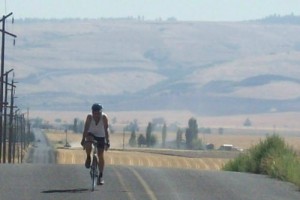 fire. You’re going to make it — you feel awesome. You have the power, determination, ability and skill to own this hill.
fire. You’re going to make it — you feel awesome. You have the power, determination, ability and skill to own this hill.
Climbing Dynamics
Don’t be intimidated. Hill climbing is attitude. Fitness plays a part, but when you understand the dynamics of hill climbing, you’re already halfway there. Contemporary road bikes have gearing for hills whether your riding a compact double, or a low-geared triple. The advantage of a specific bike makes no significant difference unless you’re on a mountain bike. The challenge comes from the mind, body, and approach.
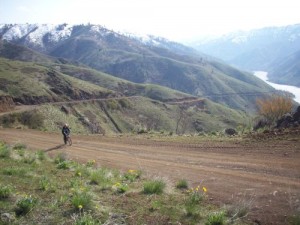
Let the Hill Come to You
Novice climbers attack too early in the climb, exhausting too much energy the first few minutes. Never attack a hill, the hill will win. Experienced climbers ignore hills, conserving energy until it gets steep enough to deserve respect. In some instances, the hill never gets that tough because experienced climbers are not intimidated.
The Technique
Enter the climb riding normally in your big gear. Focus on keeping a steady pace as you begin to slow down, shifting in back as needed to keep an even cadence. It’s fine to lose speed, it’s expected. When you hit about 10 mph, shift down to your lower gear in front — but don’t be afraid to shift early to balance your effort and aerobic system if needed. Spinning at a faster pace is better than mashing at a lower pace. If you begin to freewheel, or feel like you shifted down too soon, immediately shift to higher gears in back — one or two fast clicks should do it — to maintain the cadence you started with.
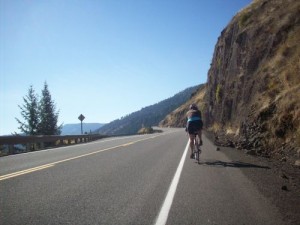
Keep it Steady
Continue riding as if you were cruising down a straight stretch. Ignore the hill. If you feel you’re running out of breath, or couldn’t carry on a conversation at this pace, shift down a click at a time in back until you can maintain an even pace. If you’re not already in the lowest gear in front, do it now. Take long, deep breaths. If you feel dizzy or faint, shift to your lowest gear immediately. If you feel stable, and your lungs aren’t burning, stay with the same gearing and cadence.
Gearing and Conditioning
The grade of the hill depicts when you reach the lowest gears in back. Don’t push big gears to show off. At this point speed is irrelevant. If you’re not swaying from side to side drastically, still climbing and moving faster than about 5 or 6 miles per hour you’re doing fine. Continue on.
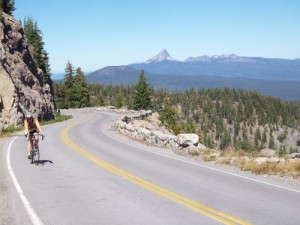
Stay in the Saddle
There comes a point when it’s OK to stand up, but not now. Stay in the saddle until you get within about 30 yards of the top — more on this later. Standing up on the bike makes your heart and lungs go anaerobic. You can’t maintain it for more than a brief period, and hitting the wall is imminent.
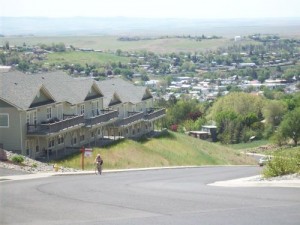
Distract Your Mind
You’ve established a pace you can maintain, probably in your lowest gear by now. If the hill is not that bad, save the lowest gear. Use it later when you can benefit from it. Continue spinning the pedals at an even pace. Don’t think about how hard your lungs and heart are pumping, even hurting. Distract yourself by thinking about something to consume your thoughts — sex is always a good mental distraction. Take long, deep breaths and keep spinning.
Body Position
Body position is important for leverage and breathing. Hands should be on the grips or brake hoods, chest and back straight to take in as much air as possible. If you feel you’re hunched forward, slide back in the saddle to position yourself over the bottom bracket. Correct body position is more efficient. Make a conscious effort to push the pedals all the way down, getting power through the full revolution from top to bottom.
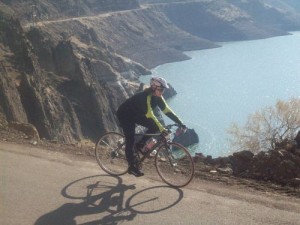
Find Your Comfort Zone
Comfort precedes almost everything. Climb at your own pace. If something restricts your movement or intake of air, remedy it by changing your position slightly. If you’re nearing your red line, back off, breath deep and find a pace you can maintain.
Stand and Deliver
Get ready to stand if the summits in range. A simple trick can propel you at an amazing rate over the top, but you can’t launch it too soon. When you’re within a few yards of a steep hill, shift up one, two or even three gears in back, and stand up. Use your body weight to mash higher gears. Because you’re climbing, high gears offer a tremendous amount of resistance. You and your bike will shoot forward, owning the hill with enough force to propel you over the top.